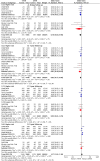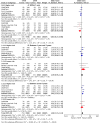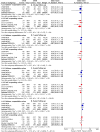Longer-term and landmark analysis of transcatheter vs. surgical aortic-valve implantation in severe aortic stenosis: a meta-analysis
- PMID: 40115441
- PMCID: PMC11922901
- DOI: 10.3389/fcvm.2025.1479200
Longer-term and landmark analysis of transcatheter vs. surgical aortic-valve implantation in severe aortic stenosis: a meta-analysis
Abstract
Background: Previous reports of longer-term outcomes of transcatheter aortic valve implantation (TAVI) focus on higher risk patients and suggest potential temporal changes.
Aims: To evaluate the longer-term and temporal performances of TAVI compared to surgical aortic valve replacement (SAVR).
Methods: Randomized controlled trials reporting outcomes with at least 1-year follow-up. The primary outcome was the composite of all-cause death or disabling stroke.
Results: We included 8 trials with 8,749 patients. TAVI was associated with a higher risk of longer-term (5-year) primary outcome compared to SAVR among higher-risk [odds ratio (OR), 1.25; 95% CI, 1.07-1.47] but not lower-risk participants [1.0 (0.77-1.29)]. However, a significant temporal interaction was detected in both risk profiles. TAVI with balloon-expandable valves was associated with a higher risk of longer-term primary outcome compared to SAVR [1.38 (1.2-1.6)], whereas no statistical difference was found with self-expanding valves [1.03 (0.89-1.19)]. There was a significant interaction between the two valve systems, and a temporal interaction was detected in both systems. Overall landmark analysis revealed a lower risk in TAVI within the initial 30 days [0.76 (0.6, 0.96)], comparable between 30 days to 2 years [1.04 (0.85, 1.28)], and higher beyond 2 years [1.36 (1.15-1.61)]. Analysis for all-cause death generated largely similar results.
Conclusions: TAVI was associated with a higher longer-term risk of primary outcome compared to SAVR in higher-risk patients and with balloon-expandable valves. However, a characteristic temporal interaction was documented in all subgroups. Future studies are warranted to test these findings.
Keywords: SAVR; TAVI; aortic stenosis; longer-term; randomized controlled trials (RCT).
© 2025 Wang, Zhang, Zhang and Xu.
Conflict of interest statement
The authors declare that the research was conducted in the absence of any commercial or financial relationships that could be construed as a potential conflict of interest.
Figures





References
-
- Mack MJ, Leon MB, Smith CR, Miller DC, Moses JW, Tuzcu EM, et al. 5-year outcomes of transcatheter aortic valve replacement or surgical aortic valve replacement for high surgical risk patients with aortic stenosis (PARTNER 1): a randomised controlled trial. Lancet. (2015) 385(9986):2477–84. 10.1016/S0140-6736(15)60308-7 - DOI - PubMed
Publication types
LinkOut - more resources
Full Text Sources

